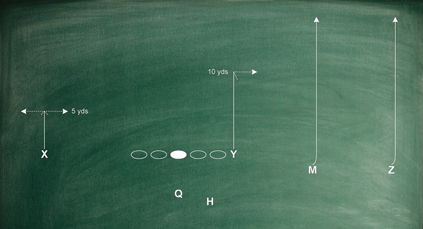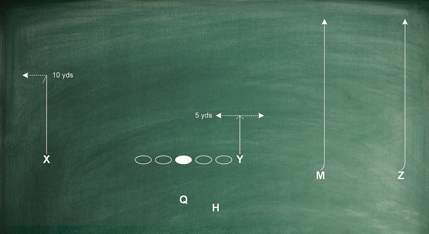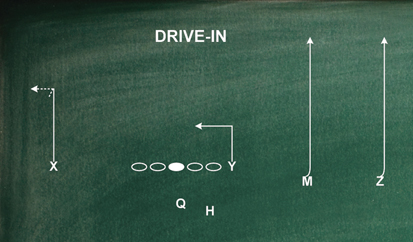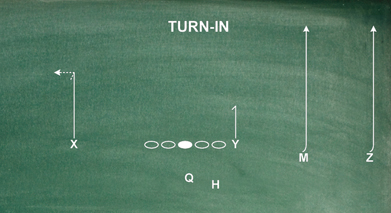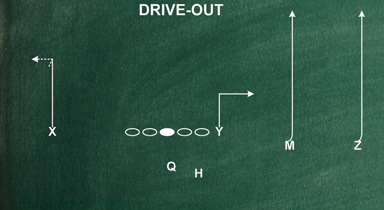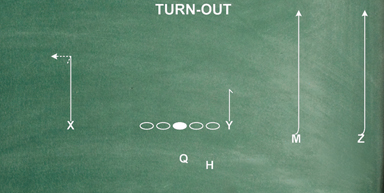Article CategoriesAFM Magazine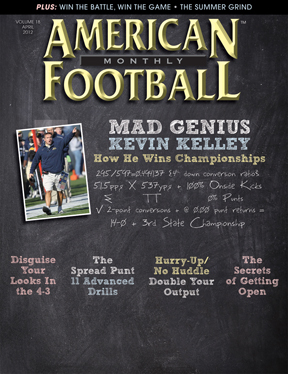
|
Open Opportunities - Get your tight end involved in the option pass game.by: Mick MiyamotoTight Ends Coach University of Dubuque © More from this issue We enjoyed a phenomenal year as an offense this past fall, averaging 490 yards per game with a 73 percent completion rate and a pass efficiency rating of 190.3. Our quarterback threw for 46 touchdowns with only eight interceptions. Our tight end had 33 catches this season and one route concept that proved to be particularly successful for us was the “Option” portion of our passing game. We throw the “Option” from multiple sets and personnel groupings but most often from either a 2 x 2 or 3 x 1 look with 11 personnel (1 running back, 1 tight end, 3 wide receivers - the X, Z, and M). The quarterback utilizes a five-step drop and the protection scheme involves a minimum of six blockers (O-line plus the running back). The protection scheme is a combination of slide and man with the running back in a dual read mode of adjacent linebackers or a linebacker and safety. The play is called with a number to signify which way the protection is sliding and then a “tag” (letter) is provided which designates which of the receivers has the “low” or five- yard option. The first receiver past the center automatically has the second or “high” option and his break point is at 10 yards. The remaining receivers in the formation run outside releases and attempt to “take the roof off of the coverage.’ Diagram 1. Since the X has received the designation, he will make his break at five yards from the line of scrimmage and has two-thirds of the width of the field in which to work. The Y in this case is the first receiver past the center and has the high option so he is instructed to make his break at 10 yards and restrict his route to the remaining one-third of the field.
Diagram 2. In this play, the Y has been tagged and makes his break at five yards from the line of scrimmage. He, in turn, has two-thirds of the width of the field with which to work. The X in this scenario is the first receiver past the center and has the high option at 10 yards. He is restricted to one-third of the field. The Z and the M are required to run the mandatory outside release verticals. Z and M options are also a staple in our attack but the focus of this article is on the tight-end running either the low or high option and not the vertical. However, the vertical route runners need to understand that they are viable receivers in every instance. The Y needs to find the path of least resistance on his release from the line of scrimmage. For example, if he is facing a 7 technique defender, then naturally he would want to release outside. Conversely, if facing a 9 technique, the preferred release would be inside. In either instance it is imperative that the tight end keeps his pad level low on his initial steps. The coaching point that I often use is “Keep your chest on your thigh board.” For this particular route I prefer that the player uses a speed release, (as opposed to a jab and club release) to get to the five-yard breakpoint as quickly as possible. His breakpoint mechanics need to be sound with his pads down and arms driving. He should strive to create the illusion to the defender that he is in fact running a vertical take-off. His options once he hits the five yard breakpoint are to:
Diagram 3.
Diagram 4. 3. Drive-out/flat route (Diagram 5).
Diagram 5. 4. Turn-out/stick route (Diagram 6). Diagram 6. If the tight end chooses to run a turn-in or turn-out, he needs to come back down the stem toward the quarterback with his hands in the “power position” (thumbs together) while his chin remains on the ball through the “catch-cap-and lock” sequence. We stress “chin on the ball” as opposed to “eyes on the ball” as it serves, in our opinion, as a more powerful reinforcement of the fundamental. If the tight end runs a drive-in or drive-out, he runs to find the void in the zone or accelerates to separate if a defender has latched on in man coverage. The quarterback will attempt to “throw to him open” with a specific target as his objective. If the Y is designated as the 10 yard or “high” option, all coaching points remain the same with the exception that he needs to be more cognizant of not carrying his route into the path of the low option route runner. In effect, he becomes a late “check down” for the QB if the low option is not open. |
|
| HOME |
MAGAZINE |
SUBSCRIBE | ONLINE COLUMNISTS | COACHING VIDEOS |
Copyright 2024, AmericanFootballMonthly.com
All Rights Reserved


